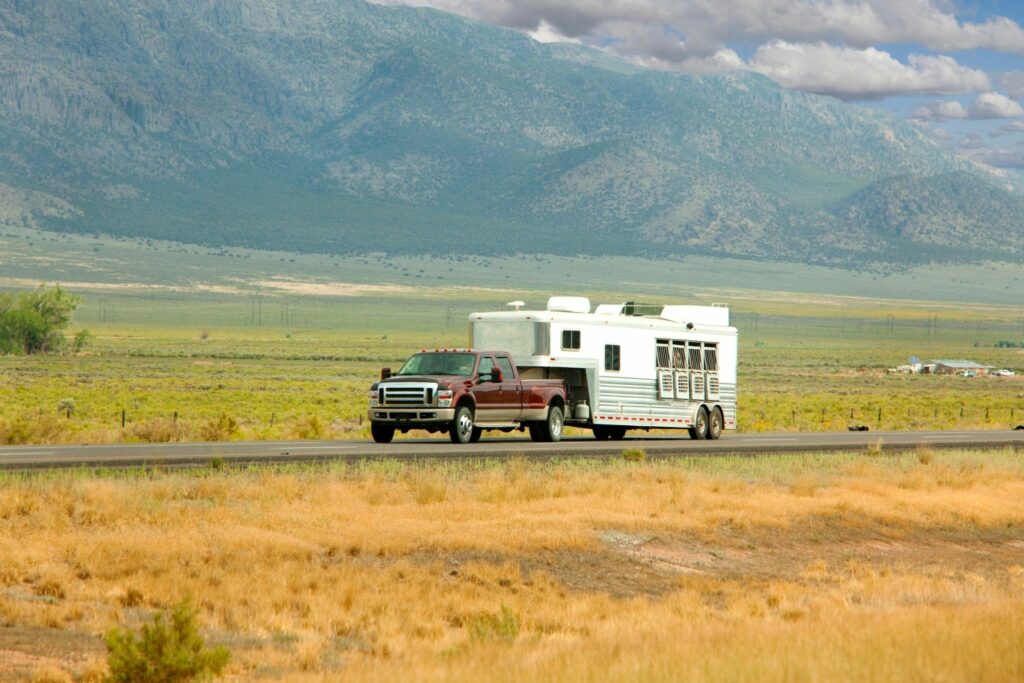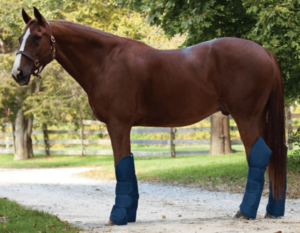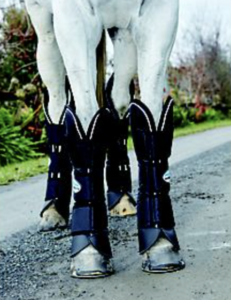Horse News
Member
Protect Those Precious Legs!
As horse lovers, we all know the feeling of wanting what is best for our horses. Shipping horses can be an incredibly stressful situation for both horse and owner.
Protecting your horse’s legs is one of the most important parts of their shipping journey. If you’re wondering if you should wrap their legs (and what you should wrap their legs with!) in the trailer, you’re not alone. Many horses get nervous in the trailer and can slip or kick while on their journey. With so many shipping boot options available, figuring out which one is best for you can be hard. We’re here to help!
Leg Wrap Basics
What’s a leg wrap?
A leg wrap is a form of protection that is provided to a horse’s leg. These can be actual wraps or a protective boot. Leg wraps not only prevent injury but can also provide support to a horse’s tendons and ligaments.
Leg wraps can be used for a variety of scenarios. They can provide protection while trailering, support or protect against an injury during exercise, and even be used for turnout.
The term ‘leg wrap’ can be synonymous with shipping boot, leg boot, and horse boots. All of these terms are referring to some form of leg protection for a horse.
Top Shipping Boot Options
| Shipping Boot Name/Brand | Price Point | Key Features |
| Roma Deluxe Shipping Boots | $ |
|
| Amigo Ripstop Travel Boots | $ |
|
| Professional Equine Shipping Boots | $ |
|
| Exselle Shipping Boots | $$ |
|
| Weatherbeeta Deluxe Travel Boot | $$$ |
|
| Classic Equine Shipping Boots | $$ |
|
Types of Leg Wraps
- Splint boots – Splint boots are typically used in the performance horse world. Riders will use splint boots to protect a horse’s legs during disciplines such as jumping, barrels, reining, and cutting.
- Sports medicine boots – Sports medicine boots provide more support than a splint boot and tend to support the tendons and ligaments during strenuous leg movements such as reining and cutting.
- Polo wraps – A polo wrap is a fleece bandage that can be used for a variety of reasons. Some riders will use them to protect a horse’s legs while jumping or racing, while others will use polo wraps over an injury to hold a bandage in place.
- Standing wraps – Standing wraps will provide protection and support for a horse’s legs. They consist of a white cloth wrap that is usually followed by a polo wrap or standing bandage. Many people will use standing wraps on their horse’s legs after a hard ride or following an injury, as it will support the leg while preventing fluid buildup.
Shipping Wraps
Shipping wraps (also called shipping boots) will provide an extra layer of protection for your horse’s delicate legs in the event they kick or slip while in the trailer. They are designed to protect legs from getting scratches and cuts in the event something does happen.
When trailering, horses will shift around and brace themselves to absorb impact from trailer movement, so it is important to protect their legs as they shift and move.
You might be wondering when to wrap and when not to wrap. In general, most people always want to wrap their horse’s legs for trailering. People will wrap regardless if their horse is going down the road or across the country.
There have been many horse owners that have had accidents occur over the years. Putting shipping boots on your horse can help to prevent some of these accidents, or protect in the event of a mishap.
There are times when wrapping your horse’s legs for trailering is not in the best interest of the horse. If you need to get your horse to the vet quickly, it is not worth the extra time to wrap your horse’s legs.
If your horse has never had wraps on before or is a very nervous traveler then wrapping your horse’s legs could pose more of a safety hazard than necessary.

Photo Cred: Canva
What to Look for When Shopping for Shipping Boots
- Price
- Durability
- Lining Type
- Size
- Type of Closures
Roma Deluxe Shipping Boots
The Roma Deluxe shipping boots come in at a great price point. These boots come in a set of four, which is great for the price point. Soft fleece lining is sometimes preferred as it provides an extra layer of comfort.
The Roma Deluxe shipping boots have extended length, which makes them an excellent choice for added protection.

Click to see them at SmartPak
PROS:
- Tough Velcro does not wear out
- Easy to put on
- Excellent price point
CONS:
- These boots can slip down during trailering
- Runs big so hard to fit for smaller horses
See them at SmartPak
Amigo Ripstop Travel Boots
The Amigo Ripstop Travel Boots are another great shipping boot option. They have an easy-to-clean nylon shell, which is always a benefit for horses that get shavings and dirt all over their boots.
The boots also come down far enough to cover the coronary band providing an extra level of protection.

Click to see them at Amazon

- Fit many sizes of horses well
- Durable quality
- Ripstop outer shell
- Several color options
CONS:
- Wider fit
- Does not cover knee, hock, or hooves
See them at Amazon
Professional Equine Shipping Boots
The Professional Equine shipping boots are an excellent option as they provide an added layer of cushion throughout the entire boot.
They have hoof coverage, which helps to prevent additional injury to the coronary band.

Click to see them at Amazon

- Multiple colors
- Shock absorbing
- Hoof protection included
CONS:
- Only one size
- No added length for protection of hock and knee joints
See them at Amazon
Exselle Shipping Boots
The Exselle shipping boots are a step up in price. They provide a great layer of added protection with a kick plate at the back of the hoof, however, so your horse cannot clip itself while in the trailer.
It also has a smooth nylon lining on the interior making them easy to clean. An outer shell made of 1000 denier makes these extremely durable.

Click to see them at Amazon

- Easy on and off
- Very padded
- Smooth lining is easy to clean
CONS:
- Run small
- May not fit larger horses
See them at Amazon
Weatherbeeta Deluxe Travel Boot
Weatherbeeta Deluxe Travel Boots are more of an investment than some of the other options available. They come with a smooth nylon lining as some of the other options do, which can make them much easier to clean after use.
They also have extended protection for hock and knee joints along with PVC strike pads at the bottom to protect your horse from stepping on themselves.
The Weatherbeeta boots come in a 1200 denier outer shell, which proves that they are extremely durable and should hold up well.

Click to see them at State Line Tack
PROS:
- Durable outer shell
- Strike pads on bottom
CONS:
- Higher price point
- Lack of color options
- Only two size options
See them at State Line Tack
Classic Equine Shipping Boots
The Classic Equine shipping boots are pricey but known to be good quality. They come in a set of four with extended protection for knee and hock joints. Additionally, they provide hoof protection at the bottom of the boot.
The hook and loop straps that they come with will ensure a secure boot that should stay in place.

Click to see them at Amazon

- Plenty of added protection
- Secure on leg
CONS:
- Higher price point
- One color
- Hook and loop closures require more time to put on and take off
See them at Amazon
Frequently Asked Questions
Q: Should I wrap my horse’s legs for trailering?
This is dependent on your individual situation and your horse. In general, wrapping a horse’s legs for trailering is a good idea. It provides that extra layer of protection while they are in the trailer.
If your horse gets nervous or has never had its legs wrapped, however, then it may not be a good idea to put boots on them.
Q: What other trailering equipment should I consider for my horse?
When trailering your horse, you might also consider bell boots if your shipping boots do not cover their hooves. This will provide that added protection. Some people also use a padded leather halter when shipping their horses.
Just as shipping boots provide protection to their legs, a padded leather halter will potentially protect their head from getting cut or banged.
Depending on the weather, you may want to trailer your horse in a light sheet. Proper ventilation is important, but you don’t want them to get chilly!
Q: Can you use polo wraps as shipping boots?
Polo wraps can be used, but they are not ideal for shipping as they are less secure than shipping boots. If they come unraveled, the horse could become tangled in the wrap, or worse, panic in the trailer.
Q: How do you measure a horse for shipping boots?
Each brand of shipping boot will have measurements available so you know how to measure for that specific shipping boot. Most of the time you will be measuring from their coronary band up the leg to the knee or hock joint.
It is important to look at the measurement guide for the boot you choose to purchase.
Q: How much does it cost to have your horse shipped?
Shipping costs will vary. The cost to ship your horse will depend on how far they are being shipped, how large the trailer is, if there will be other horses on the trailer, and what type of trailer they will be shipped in.
There are people who will haul horses in standard slant-load trailers of different sizes and large horse transportation companies that will ship horses across the country in a stall-sized space on a semi with shock absorption.
Most shippers will charge by the mile, but if your horse will be sharing the ride with others, this will greatly reduce the cost to you.
Parting Thoughts
The process of shipping your horse can be stressful, but being proactive and protecting your horse while on the road will ease some of that worry. Safe travels!
P.S. Enjoy this article? Trot on over to:
- Shipping Boots vs. Standing Wraps – What Do I Use?
- 4 Dressage Fashion Trends & Salute-Worthy Styles
- Shipping Boots vs. Stocking Wraps – What Do I Use?
- 9 Best Splint Boots for Protecting Hard-Working Horses
- 3 Best Horse Mounting Blocks
- 5 Comfy Tall Riding Boots That Look as Good as They Feel
- 3 Best Dressage Boots for the Perfect Leg Position
- 10 Best Brands of No-Regrets Breeches
- Fashion Dos and Don’ts for Horse Show Spectators
The post 6 Best Shipping Boots for Horses on the Move appeared first on Horse Rookie.
Continue reading...
